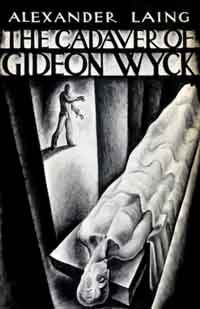 By Alexander Laing (Macmillan; 1934/60)
By Alexander Laing (Macmillan; 1934/60)
A real curiosity: a strange, rather morbid mystery that in recent years has received attention as a novel of horror (having been favorably profiled in the essential HORROR: THE 100 BEST BOOKS and TWILIGHT ZONE MAGAZINE’S seminal August ’83 “Fantasy Five-Foot Bookshelf”). That’s doubtless due to the many bizarre and grotesque elements author Alexander Laing includes, such as the near simultaneous birth of five mutant babies and the last-minute revelation that a pivotal character has a half-formed twin brother attached to his body.
The majority of this first person account is told by a medical student looking to solve the murder of Professor Gideon Wyck. Said killing doesn’t occur until about fifty pages into the novel, the first portion being consumed with the living Wyck’s bizarre behavior, in particular a strange malady he appears to be suffering from, which would seem to contradict his oft-repeated claims that he’s “never been sick a day in my life.” Further conflict comes in the form of a disgruntled student of Wyck’s and an amputee patient who claims the not-so-good professor has been siphoning blood from him.
Suddenly Wyck is murdered under mysterious circumstances, and the search for the killer is on. As a pure mystery story THE CADAVER OF GIDEON WYCK frankly leaves something to be desired. The details of the mystery’s unraveling feel perfunctory and unnecessary; the culprit, revealed in a lengthy courtroom-set climax (after the protagonist himself spends time in jail for suspicion of the murder), turns out to be the most obvious possible suspect in the entire story (chances are you’ve already figured it out based on the details I’ve revealed thus far).
Then again, though, there’s a reason this story is remembered nowadays (if at all) as horror themed. As I stated earlier, it has a genuinely unsettling, macabre edge, particularly evident in the climax, when we learn exactly what Wyck was up to when he was murdered. I won’t give the “secret” away, but I will say it involves research on a deranged, possibly supernatural experiment that’s infinitely stranger and more compelling than the details of the killing itself!
Far less enticing is Laing’s insistence on presenting his fictional narrative as an actual document. Lengthy and distracting footnotes are scattered throughout attesting to this “fact,” as is an introduction and byline claiming the book was “Edited By” Laing, with authorship credited to an anonymous “Medical Student.” Fine and good (similar stunts are still utilized today in books and films–THE BLAIR WITCH PROJECT, anyone?), but far too much energy is expended on this ultimately tiring masquerade.
Beyond that, though, the novel is penned in a smooth and straightforward manner fully befitting a dedicated medical student. Its small town college atmosphere is vividly evoked, with quite a few convincing details (which the “editor’s” footnotes frequently take pains to point out). Laing is a skilled writer; apparently quite prolific back in the thirties, he was already a veteran when GIDEON WYCK was written. His characterizations are strong, if a tad slight–like innumerable mysteries past and present, it’s the story that takes center stage here, often at the expense of nearly everything else.
One more thing: the version under review of this extremely scarce novel is a 1960 abridgment published by Macmillan’s Mystery Revisited series (itself a very rare find). I’ve never read the unexpurgated 1934 version and so can’t say how the two differ. What I can say for certain is that this 228-page abridgment by the author is a smooth and uncluttered piece of work (even if the story overall leaves something to be desired), so much so that I find it difficult imagining just what else the original version could have possibly included.
